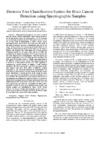Identificador persistente para citar o vincular este elemento:
https://accedacris.ulpgc.es/jspui/handle/10553/52646
| Título: | Decision Tree Classification System for Brain Cancer Detection using Spectrographic Samples | Autores/as: | García Dópido, Inmaculada Déniz, Cassandra Fabelo, Himar Callico, Gustavo Lopez, Sebastian Sarmiento, Roberto Bulters, Diederik Casselden, Elizabeth Bulstrode, Harry |
Clasificación UNESCO: | 3314 Tecnología médica | Palabras clave: | Brain Cancer Detection Hyperspectral Imaging Support Vector Machine |
Fecha de publicación: | 2016 | Publicación seriada: | Proceedings (Conference on Design of Circuits and Integrated Systems) | Conferencia: | Conference on Design of Circuits and Integrated Systems, DCIS 2015 | Resumen: | Hyperspectral imaging is an active research field for remote sensing applications. These images provide a lot of information about the characteristics of the materials due to the high spectral resolution. This work is focused in the use of this kind of information to detect tumour tissue, particularly brain cancer tissue. In recent years, the study of this kind of tumour has been a challenging task due to the nature of these tissues. The neurosurgeon usually finds several problems to detect tumour tissues by the naked eye. In order to address this problem, this work makes use of high spectral resolution samples in the range from 400 nm to 6000 nm, provided by an Agilent Resolutions Pro V.5 spectrometer that has been diagnosed by histopathology. This instrument can sample a single pixel with a very high spectral resolution. The high spectral resolution allows a reliable separation between the different tissues in brain tumour. The proposed approach is based on a hierarchical decision tree. This approach is composed by several systems of Support Vector Machine classifiers. The 225 used samples come from 25 adults (males and females) and have been taken at different surgical procedures at the University Hospital of Southampton. The main goal is to discriminate between tumour tissue and normal tissue. Specifically, it assigns priority to the group of classes known a priori to the classification showed accordingly to the level of detail. The experimental results indicate that the use of the proposed new decision tree approach could be a solution to effectively discriminate between tumour and normal tissue and additionally provide information about the specific tissue for these classes. For our data set, a sensitivity of 100% and a specificity of 99.27% have been obtained when healthy and tumour samples are discriminated. These results clearly indicate that the use of high dimensionality spectral data is a promising and effective technique to indicate if a brain sample is or not affected by cancer with a high reliability. | URI: | https://accedacris.ulpgc.es/handle/10553/52646 | ISBN: | 9781467372282 | ISSN: | 2471-6170 | DOI: | 10.1109/DCIS.2015.7388596 | Fuente: | 2015 Conference On Design Of Circuits And Integrated Systems (Dcis)[ISSN 2471-6170], (2015) |
| Colección: | Actas de congresos |
Citas SCOPUSTM
1
actualizado el 08-jun-2025
Citas de WEB OF SCIENCETM
Citations
2
actualizado el 25-feb-2024
Visitas
142
actualizado el 20-may-2023
Descargas
6
actualizado el 20-may-2023
Google ScholarTM
Verifica
Altmetric
Comparte
Exporta metadatos
Los elementos en ULPGC accedaCRIS están protegidos por derechos de autor con todos los derechos reservados, a menos que se indique lo contrario.
